wagon trains
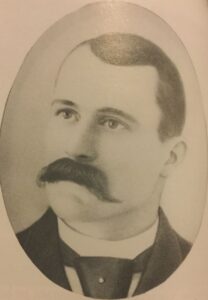
 As the westward movement progressed different areas began to emerge as important places along the trail to places like Utah, Oregon, and California. One of those important places, as it turns out, was Casper, in what would one day be the state of Wyoming. On the journey west, water was essential, and so the wagon trains often followed and even crossed the rivers as the terrain necessitated. Because the future city of Casper was located on the banks of the North Platte River, it was a logical location for a town, that later became a city. In order to locate a cut through the Rocky Mountains, the Platte River proved to be the key.
As the westward movement progressed different areas began to emerge as important places along the trail to places like Utah, Oregon, and California. One of those important places, as it turns out, was Casper, in what would one day be the state of Wyoming. On the journey west, water was essential, and so the wagon trains often followed and even crossed the rivers as the terrain necessitated. Because the future city of Casper was located on the banks of the North Platte River, it was a logical location for a town, that later became a city. In order to locate a cut through the Rocky Mountains, the Platte River proved to be the key.
As the trail of emigrants made their way across the continent, Casper was formed, and a man named John Baptist Richard could see that the river could be a necessity as a water source, but also a hinderance in that crossing it wasn’t always easy. A ferry had been established in 1847 to get emigrants across the Platte River on their way west on the Oregon-California Trail, but later Richard two bridges were erected in the 1850’s to improve the passage of settlers on their westward march. The first bridge was built in 1851 just east of present-day Casper, in the area of present-day Evansville. The second bridge became much more successful bridge and was built in 1859-1860. This bridge came to be known as the “Platte Bridge” and was a important mark on the Oregon-California trail. Later, with the establishment of the Platte Bridge Station in 1858, renamed Fort Caspar by the military in 1864 the fort and the bridge were major forces that contributed to the formation of Casper. Fort Caspar was abandoned in 1867, but the town of Casper remained, and was prosperous.
The military no longer needed the fort, and shortly thereafter, the bridges burned by the Indians. A short time later, white settlers began to develop the area. It turned out that the area was perfect for ranching. From the 1860’s through the 1880’s large cattle ranches were established near Casper. Ranches such as the Sun Ranch on the Sweetwater, the Goose Egg Ranch of the Seebright Brothers at Bessemer Bend, the Carey Ranch near the old Platte Bridge, and the Brooks Ranch east of modern-day Casper dotted the landscape.
It was about this time that John Merritt and C W Eads learned of this railroad expansion. It is believed that they were the first to arrive in what would eventually be known as Casper. On the afternoon of June 7, 1888, they pitched a tent at a spot near what is today known as McKinley and “A” Streets and established the town of Casper. As the city grew, this area would become known as “Old Town.” The town grew slowly and for two decades was one of a number of small villages dotting the plains serving local cattle operations. As in most frontier towns, the standard businesses were quickly established…four saloons and restaurants, three livery stables, one grocery store, and two general stores. As was also common, most buildings were frame construction. At that time, there were fewer than a thousand people living in the town. Marvin Lord Bishop Sr moved to Casper, Wyoming on September 1, 1892, after being appointed postmaster by President Grover Cleveland the 22nd President of the United States and a member of the Democratic Party. He later changed his affiliation to the Republican Party. His party affiliation resulted in his appointment to this prestigious position of postmaster in the developing community of Casper. While he was not the first postmaster, he was the first person to stay in the position for more than two years and is credited with bringing stability and permanence to the office as the fledgling community developed. The postmaster was on duty from 7:00am to 9:00pm…so much for bankers hours there. The salary ranged from $50.00 to $100.00 per month which would be between $1750 and $3500 today…not a bad wage, especially considering that little mail was handled in those early days. Trips to town were not an everyday occurrence for the ranchers, so when they came in, about every four months, their first stop was often the post office to get the mail that had accumulated since the last visit or since a neighbor had last brought it to them.
In addition to the post office, Mr Bishop also had a small store attached to the post office, that he also operated. It was called M. L. Bishop’s Cash Store for “Fine Family Groceries” and was one of the few businesses established in Casper in the 1890s. Bishop also helped to establish one of the earliest churches in Casper, the First Methodist Episcopal Church, now known as the First United Methodist Church. He was one of five men in Casper who met in the early spring of 1893 to discuss the importance of establishing a religious community in the developing town of Casper and to formulate plans for the formation of this church. In 1896, the church had 22 members, out of which the Bishop family, now numbering six, held a significant presence.
Because the position of postmaster was a political patronage position, Bishop began to make plans for his future, in the event of a political climate change. In May 1894 he entered into sheep ranching, purchasing land from Edward T David, another early pioneer and foreman for the Carey Ranch. His resignation as Postmaster in August 1898 began a period of 40 years when M L Bishop became a woolgrower with holdings in the Pathfinder Dam area southwest of Casper and the owner of the sheep shearing pens located at Casper Creek. Over the years, and due to some twists of fate, like the Civil War, and the movement of wool growing from the East to the Western plains and mountains, brought much wealth to the Bishop family. With Bishop’s businesses were thriving and he decided to purchase land at 818 East Second Street for a new home in 1906. He bought two adjacent lots on East Second Street in Casper in the Capitol Hill Addition from another early pioneer, Robert White. The contractor for the Bishop Home was W T Evans, founder of Evansville, Wyoming. Mr Evans built numerous other buildings in the burgeoning town of Casper such as the Town Hall in 1890 and the Saint Mark’s Episcopal Church in 1891. In addition, he built the first one-story, four-room brick home at First and Wolcott streets for his daughter and son-in-law in the late 1890’s. This home was considered one of the largest homes in Casper until Mr. Evans built the two and one-half story Bishop home with fifteen rooms. The Bishop house, built in 1907, is believed to be his first venture into large-scale, multi-story family homes.
By 1929, the year the stock market crashed, the oil boom was coming to an end, also. The boom had been furious, powerful, and seemingly endless, and before it faded from sight, that boom had made Casper, Wyoming what it was and largely what it remains today. Always a “boom and bust” town, Casper would survive whatever came its way.
In 1938, Bishop was elected County Commissioner and his years of accumulated knowledge of sheep ranching were recorded that same year by the Wyoming Works Progress Administration (WPA). He died the following year. With his death, the strains on the economy from the great depression, and the decline in the Wyoming sheep production, the family could not maintain the ranch and shearing pens. Wyoming. Bishop’s wife, Leona, continued to live in the home until her death in 1948. In total the couple had ten children. All children resided in Wyoming and were prominent in their communities with the exception of one daughter who died in infancy. T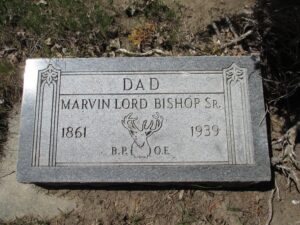
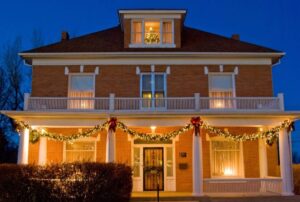 heir youngest daughter, Lucile L Bishop, lived in the family home from the time of her birth in October 1908 until her death in 1997. Then, the M L Bishop House was placed on the National Register of Historic Places because of its association with the development of Casper and the surrounding area from a small village to a livestock center, and eventually, to an oil town. The home is still open for tours, and I plan to go in the near future.
heir youngest daughter, Lucile L Bishop, lived in the family home from the time of her birth in October 1908 until her death in 1997. Then, the M L Bishop House was placed on the National Register of Historic Places because of its association with the development of Casper and the surrounding area from a small village to a livestock center, and eventually, to an oil town. The home is still open for tours, and I plan to go in the near future.
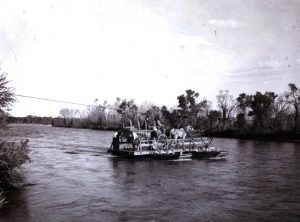 Trips across the United States in the mid-1800’s were slow and often treacherous. The trips were taken on wagons pulled by horses or oxen. It took months to get across the nation, and many people did not make it. Illness, Indian attacks, heat, cold, or animal bites, all served to cause problems, but one of the worse dangers was water. Of course, water could be bad and filled with bacteria, but more importantly, water, in the form of rivers could make crossing extremely dangerous and sometimes deadly. Rivers that were swift or deep, could mean the end for wagons, animals, and for people.
Trips across the United States in the mid-1800’s were slow and often treacherous. The trips were taken on wagons pulled by horses or oxen. It took months to get across the nation, and many people did not make it. Illness, Indian attacks, heat, cold, or animal bites, all served to cause problems, but one of the worse dangers was water. Of course, water could be bad and filled with bacteria, but more importantly, water, in the form of rivers could make crossing extremely dangerous and sometimes deadly. Rivers that were swift or deep, could mean the end for wagons, animals, and for people.
One such danger, located on the Oregon Trail, where emigrants made their way to Oregon, California, and Utah, was the North Platte River near present day Casper, Wyoming. In those days, there were many people looking to make a living in something besides the gold industry, which wasn’t always successful for the majority of people, so they set up things like commercial ferries to transport wagon trains across the treacherous rivers, like the North Platte River. It was a safer way to cross the rivers, to be sure, but it was also expensive, and so many people tried to cross on their own. Mostly due to their inexperience, many people lost everything trying to cross, sometimes even their lives. Many emigrants, unwilling to pay, tried to fashion their own “ferries,” with varying success. Until bridges were built, nearly all travelers swam their livestock across, and many people and animals drowned in the swift, deep, shockingly cold water of the Platte.
From present-day central Nebraska to South Pass in west-central Wyoming, emigrants to California, Oregon and Utah all took more or less one route. Most of the wagon trains came up the south side of the Platte from Fort Kearney. They crossed the South Platte in western Nebraska where the river forks, and continued west, going up the south side of the north fork. This route meant that they would have to ford the Laramie River where it joined the North Platte at Fort Laramie. Then, finally they could cross the North Platte itself 150 miles later, where the river turned to go to the south near present Casper. Once they made the treacherous North Platte River crossing, the travelers could continue on to the west. There was simply no other way to get there from the East at that time in history.
Routes changed periodically, including crossings at Red Buttes, west of Casper during fur-trade times in the 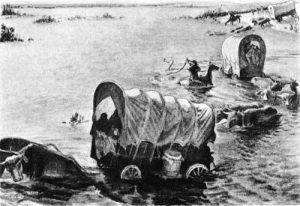 1820s and 1830s. Crossing points varied more and more during the mid-1840s, including along 25 miles of river from the mouth of Deer Creek, at present-day Glenrock, Wyoming to Casper, Wyoming. Many people crafted small boats by emptying their wagons, removing the wagon box from the running gear, caulking the boxes water tight with tar, dismantling the running gear into pieces, and then ferrying everything across the water in the wagon boxes. Wow!! What a long drawn out, time consuming way to build a boat. Them they used poles or oars for guidance and often using ox or human power to tow the craft across the water with long ropes. This was a fairly reliable method, as I said very slow due to the unloading, dismantling, and reloading.
1820s and 1830s. Crossing points varied more and more during the mid-1840s, including along 25 miles of river from the mouth of Deer Creek, at present-day Glenrock, Wyoming to Casper, Wyoming. Many people crafted small boats by emptying their wagons, removing the wagon box from the running gear, caulking the boxes water tight with tar, dismantling the running gear into pieces, and then ferrying everything across the water in the wagon boxes. Wow!! What a long drawn out, time consuming way to build a boat. Them they used poles or oars for guidance and often using ox or human power to tow the craft across the water with long ropes. This was a fairly reliable method, as I said very slow due to the unloading, dismantling, and reloading.
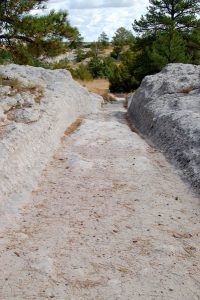 In the years when my kids were in elementary school, every kid in probably 4th or 5th grade got to take a field trip to Guernsey, Wyoming to see the Oregon Trail ruts located there. I don’t know if that is a field trip the schools take anymore, but they did then. Of course, I had seen the Oregon Trail many times before, because my parents loved showing us the history all around us, including stopping at just about every place where the Oregon Trail crossed the highway on our travels. Still, I did not recall seeing the ruts located at Guernsey before, so as a parent who got to go along, it was quite a treat. I was fascinated by the fact that those wagons could make ruts in the rocks. So many of the areas of the Oregon Trail are just a path, or you can’t even tell it’s trail. You just know that it’s where the trail is because of the marker. But there, in the rocks near Guernsey, years after the Oregon Trail was in use, the ruts remain.
In the years when my kids were in elementary school, every kid in probably 4th or 5th grade got to take a field trip to Guernsey, Wyoming to see the Oregon Trail ruts located there. I don’t know if that is a field trip the schools take anymore, but they did then. Of course, I had seen the Oregon Trail many times before, because my parents loved showing us the history all around us, including stopping at just about every place where the Oregon Trail crossed the highway on our travels. Still, I did not recall seeing the ruts located at Guernsey before, so as a parent who got to go along, it was quite a treat. I was fascinated by the fact that those wagons could make ruts in the rocks. So many of the areas of the Oregon Trail are just a path, or you can’t even tell it’s trail. You just know that it’s where the trail is because of the marker. But there, in the rocks near Guernsey, years after the Oregon Trail was in use, the ruts remain.
The Oregon Trail is a 2,170 mile wagon route trail that meandered from the Missouri River to Oregon. It was first laid by fur traders and trappers from about 1811 to 1840. During those years, it was only passable on foot or by horseback. Then by 1836, the wagon trains began to head from Independence, Missouri to places in the west. The trail had been cleared to 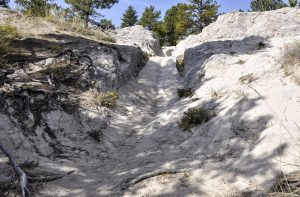 Fort Hall, Idaho by then. As time went on, the trail was cleared all the way to the Willamette Valley in Oregon. These days, the trail crosses our highways in many places, and markers have been placed so the travelers can learn a little history of the trail and what might have happened at each part of it. At the time my parents were showing us all those markers, my sisters and I usually groaned about stopping yet again, at another of the endless Oregon Trail markers that, at that time, we dreaded being forced to read all about. These days, when I think back, I can appreciate the things they tried to show us in this great nation of ours. And I can appreciate the ruts in the rocks outside of Guernsey that have endured for 184 years.
Fort Hall, Idaho by then. As time went on, the trail was cleared all the way to the Willamette Valley in Oregon. These days, the trail crosses our highways in many places, and markers have been placed so the travelers can learn a little history of the trail and what might have happened at each part of it. At the time my parents were showing us all those markers, my sisters and I usually groaned about stopping yet again, at another of the endless Oregon Trail markers that, at that time, we dreaded being forced to read all about. These days, when I think back, I can appreciate the things they tried to show us in this great nation of ours. And I can appreciate the ruts in the rocks outside of Guernsey that have endured for 184 years.

